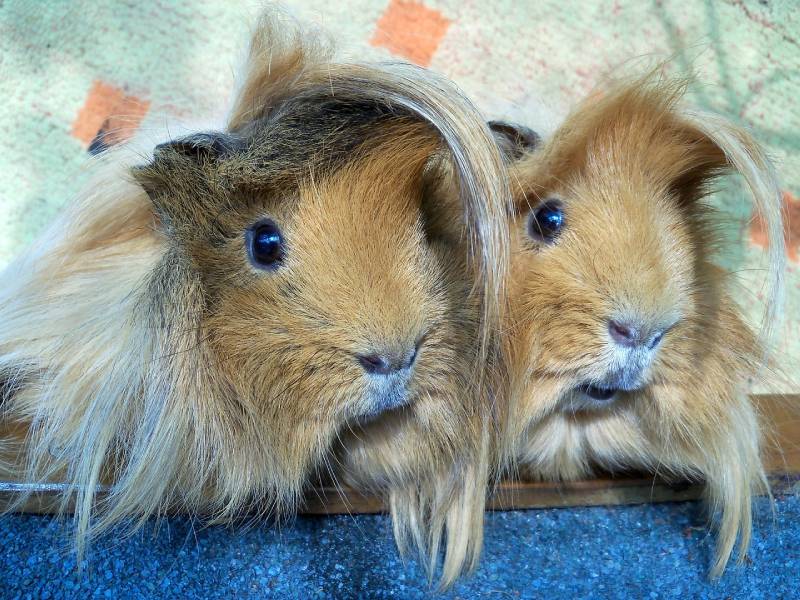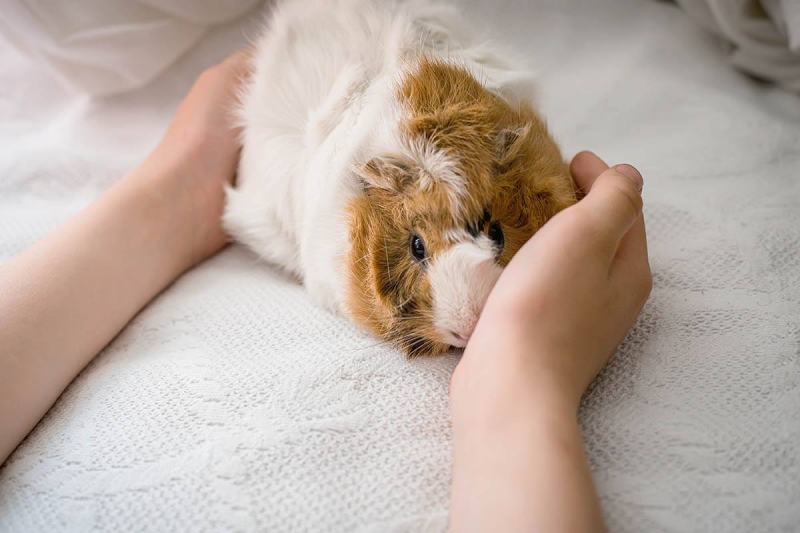Peruvian Guinea Pig: Pictures, Temperament, Diet, Care Guide & More

Updated on
Click to Skip Ahead
Known for their luxurious locks, the Peruvian guinea pig is the “hippie” guinea pig with a personality to match. Among the sweetest of cavies, the Peruvian guinea pig is a popular pet, but they’re not right for everyone. Peruvian guinea pigs have much higher maintenance grooming needs than your standard cavy, so they’re not ideal for a first-time guinea pig owner.
Wondering if the Peruvian guinea pig is right for you? Here’s everything you need to know about this breed’s temperament, health, and requirements.
| Size: | Large |
| Weight: | 1 to 3 lbs |
| Lifespan: | 4–6 years |
| Similar Breeds: | Abyssinian guinea pig, Sheltie guinea pig |
| Suitable for: | Experienced rabbit owners with other rabbits |
| Temperament: | Sweet, easygoing, friendly |
The Peruvian guinea pig is one of the oldest guinea pig breeds on record. They originate from South America but didn’t become popular pets until around the 16th century when French European traders shipped them from Peru to Europe. Now, they’re recognized by both the American Cavy Breeders Association and the British Cavy Council.
Peruvian Guinea Pig Characteristics

How Much Do These Guinea Pigs Cost?
As one of the more popular cavy breeds, Peruvian guinea pigs are abundant on the pet market. They can be a little pricey, though. For comparison, the American guinea pig, one of the most common short-haired guinea pigs, costs around $25. The Peruvian guinea pig commands prices around $40 or $50, much like the other long-haired Alpaca and Abyssinian guinea pigs. They’re widely available from breeders and pet stores, but you may find them in rescues or shelters as well.

Temperament & Intelligence of the Peruvian Guinea Pig
Like other guinea pigs, Peruvian guinea pigs are highly sensitive, perceptive, and intelligent. They can learn tricks and come to their name when called. They can identify their humans by smell, sight, and sound, and remarkably, they have the emotional intelligence to understand when their human is tired or upset.
These cavies are gentle and kind, but it’s important to spend time with them with training and playtime, as that intelligence and sensitivity can cause boredom and stress if their needs aren’t met. They do well when they have a lot of variety in their day-to-day interactions, including advanced trick training.
Do These Guinea Pigs Make Good Pets? 👪
Yes, the Peruvian guinea pig makes a great pet. These cavies are friendly, sociable, and sweet-natured. Aside from their beauty, people keep Peruvians because of their cuddly and lively personalities. They’re also curious and want to spend time with their owners, so they’re not a display pet.

Does This Guinea Pig Get Along With Other Pets?
Guinea pigs do well in colonies, which also applies to the Peruvian guinea pig. They get along well with other guinea pigs, but it’s important to make sure that everyone is spayed and neutered to avoid accidental litters. As a prey animal, guinea pigs should not be allowed to interact with dogs or cats, no matter how friendly they seem. There’s not only a risk of your dog or cat harming your cavy, but the stress of the situation could cause health problems for the guinea pig.

Things to Know When Owning a Peruvian Guinea Pig:
Food & Diet Requirements 🥕
Peruvian guinea pigs need a proper balance of pelleted food, hay, and fresh vegetables. Like other guinea pigs, they can’t make their own vitamin C and need to get it from their diet. Your cavy should have an unlimited quantity of fresh timothy hay each day, pelleted food fortified with vitamin C, and a rotation of vitamin C-rich vegetables and fruit daily.
Habitat & Hutch/Enclosure Requirements 🏠
Guinea pigs do not jump or climb, so it’s more important to have a larger enclosure with plenty of floor space. One guinea pig can have a cage that’s a minimum of 30” by 36”, but bigger is always better. Plan another three square feet per additional guinea pig. A rodent cage is more suitable for a guinea pig than plastic tubs, glass aquariums, or cages with wire floors.
Exercise & Sleeping Needs 🐹
Guinea pigs should have at least three or four hours of free-range playtime each day. If you have a larger enclosure with space to exercise, your guinea pig may need less time outside of their cage. Guinea pigs that have outside time and workouts are generally better adjusted and happier. With the Peruvian, it’s important to have this time for not only exercise but bonding, as they get attached to their owners.

Training
Like other guinea pig breeds, Peruvian guinea pigs are intelligent, docile, and easy to train. They can be trained to use a litter box, push a ball, spin in a circle, jump through a hoop, or come when called. Training is easiest with positive reinforcement and treats as a motivator, but it’s important to avoid overfeeding and making your guinea pig overweight or ill.
Grooming ✂️
Peruvian guinea pigs are high maintenance to groom. Unlike other breeds, they are unable to groom themselves properly. Along with spot cleaning and regular cage cleaning, your cavy will need daily brushing and regular baths to keep their fur clean and detangled. A soft brush or fine tooth comb is ideal for working through your guinea pig’s coat gently. If you don’t keep up with your Peruvian Guinea Pig’s coat, they can get tangles, mats, and skin problems.
It’s best to use a fleece cage liner to ensure that your guinea pig doesn’t get a lot of hay, paper, or wood shavings in their coat. Their hair grows quickly, so most Peruvians will need monthly haircuts to prevent their hair from growing past their feet.
Lifespan and Health Conditions 🏥
Peruvian guinea pigs have a healthy lifespan of four to six years. They are susceptible to many of the same health conditions as other guinea pigs, including respiratory infections, gastrointestinal diseases, abscesses, and scurvy, a vitamin C deficiency. In addition, the Peruvian’s long coat leaves them susceptible to other health conditions, such as heatstroke, ear mites and infections, and flystrike, a condition in which flies lay eggs in their skin and the maggots burrow out.
- Respiratory infections
- Gastrointestinal diseases
- Ear mites and infections
- Scurvy
- Abscesses
- Heatstroke
- Flystrike

Male vs Female
Choosing a male or a female Peruvian guinea pig comes down to personal preference. Males tend to be slightly larger, while the females can be more standoffish. They vary by individual, however, so you could have a male that’s more independent or a female that’s more affectionate. Either way, you should spay or neuter your guinea pig to avoid behavioral problems associated with sex hormones, as well as health conditions that can affect the reproductive organs.

3 Little-Known Facts About Peruvian Guinea Pigs
1. They May Not Be From Peru.
Despite the name, Peruvian guinea pigs aren’t necessarily from Peru. They still have wild cousins roaming throughout South America, primarily in Brazil, Bolivia, Uruguay, and Argentina.
2. They Need Hairdos.
Peruvian guinea pigs have long locks that grow on their sides, but they also have a rosette of fur on the top of their head. Left to grow wild, this hair will grow the same length of the body, giving the guinea pig “bangs” that can affect their vision.

3. They Can’t Groom Themselves.
Most guinea pigs have shorter hair and engage in social grooming behaviors that do a lot of the owner’s work. They secrete a milky fluid from the eyes that other guinea pigs drink and use to clean each other’s fur. Peruvian guinea pigs can’t engage in social grooming, even in colonies, because of the length and volume of their fur. They will chew each other’s hair to thin or shorten it, but most of the work is on the owner to keep the hair trimmed and tangle-free.

Final Thoughts
Peruvian guinea pigs are the stars of the cavy world for their looks and personalities, but this isn’t a pet to be taken lightly. While they’re friendly, loving, and easy to train, Peruvian guinea pigs need a lot more grooming than other cavies, so they’re not for a casual owner. If you neglect this breed’s grooming needs, it can end up with serious and painful health conditions. If you want to bring home a Peruvian guinea pig, be prepared to put more work into its coif than your own.
Featured Image Credit: lino9999, Pixabay










